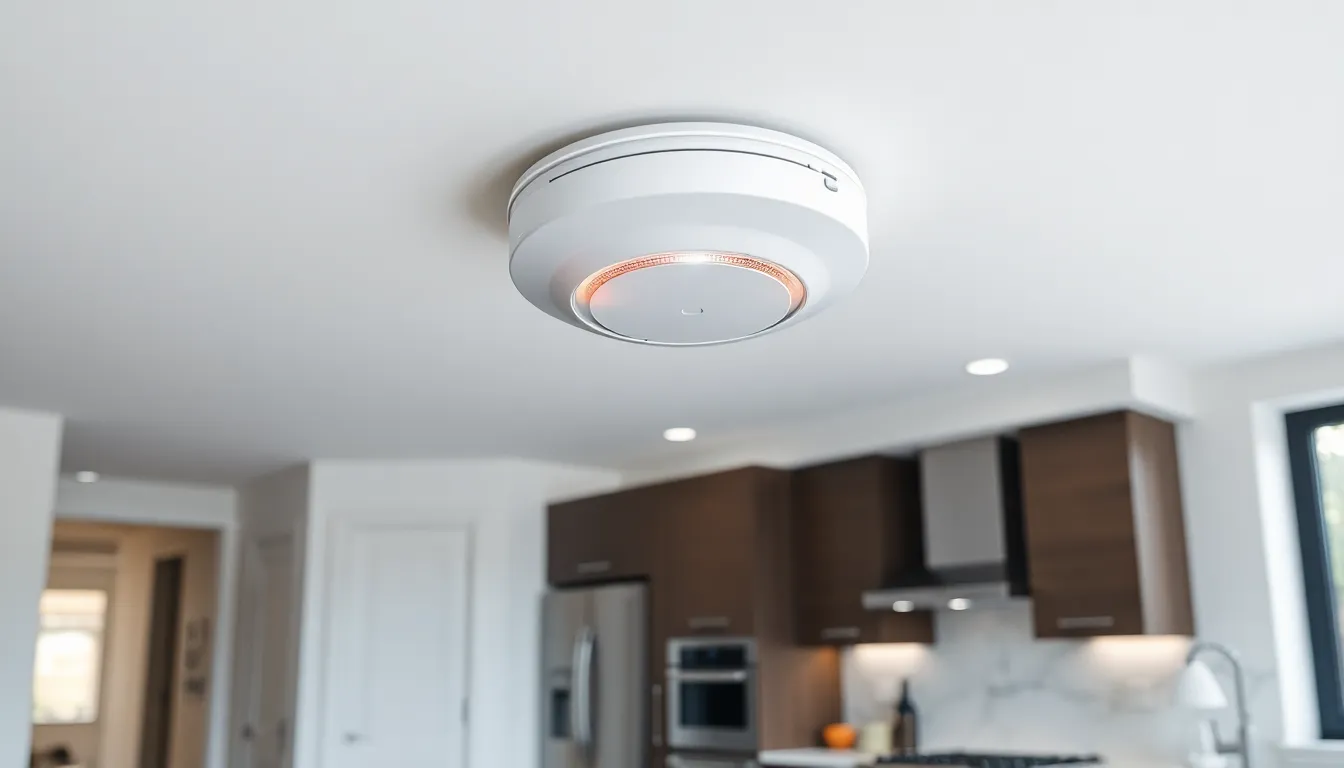Table of Contents
ToggleIn a world where everything seems to be getting smarter—from phones to refrigerators—why should smoke detectors be left behind? Enter the smart smoke detector, the unsung hero of home safety that not only alerts you to danger but also makes you feel like you’re living in the future. Gone are the days of annoying beeping and frantic searches for a ladder; these high-tech gadgets talk to you, send alerts to your phone, and even distinguish between smoke and steam.
Overview of Smart Smoke Detectors
Smart smoke detectors represent a significant advancement in fire safety technology, offering users enhanced features for improved protection. These devices deliver more than just alerts; they incorporate smart technology to enhance user experience and response time.
What Are Smart Smoke Detectors?
Smart smoke detectors are advanced versions of traditional smoke detectors. They integrate connectivity features that allow communication with smartphones and smart home systems. These devices often provide real-time updates, enabling users to monitor home safety remotely. Users can receive alerts about smoke detection and potential dangers, even when away from home. Many models distinguish between smoke and non-threatening steam, reducing false alarms. With voice notifications, smart smoke detectors offer clear instructions during emergencies, ensuring users respond quickly and effectively.
How Do Smart Smoke Detectors Work?
Smart smoke detectors utilize various technologies to ensure efficient operation. These devices often connect to a home’s Wi-Fi network, allowing for remote notifications via smartphone apps. User-friendly interfaces enable easy monitoring and management of alerts. Many detectors utilize both photoelectric and ionization sensors to detect smoke particles quickly. When smoke is detected, the device alerts users through mobile notifications and in-home alarms simultaneously. Some models even allow users to customize alert settings according to their preferences, enhancing responsiveness. Overall, smart smoke detectors combine advanced detection techniques with connectivity for a safer living environment.
Benefits of Smart Smoke Detectors

Smart smoke detectors offer multiple advantages that significantly improve fire safety within homes. These devices not only alert individuals to smoke presence but also incorporate advanced features for greater effectiveness.
Enhanced Safety Features
Enhanced safety features define smart smoke detectors. Many devices provide voice notifications that guide users throughout emergencies, offering clarity during chaotic situations. Users can expect these detectors to differentiate between smoke and steam, reducing false alarms that often disrupt daily life. Models equipped with photoelectric and ionization sensors maximize detection capabilities, ensuring rapid alerting in various fire scenarios. A key benefit includes the ability to self-test, which helps maintain functionality over time.
Connectivity and Automation
Connectivity and automation play crucial roles in smart smoke detectors. Most units connect to Wi-Fi networks, allowing for real-time notifications via smartphones. Users receive alerts regardless of distance, enhancing peace of mind, especially while away from home. Integration with smart home systems simplifies management. Users can automate responses, such as turning on lights or notifying emergency services during an incident. This interconnectedness improves user responsiveness, facilitating quicker actions when seconds count.
Popular Brands and Models
Several brands offer reliable options in the smart smoke detector market, with notable features and performance metrics showcasing their capabilities.
Brand A Features and Performance
Brand A excels in voice alert technology, providing clear instructions during emergencies. Its photoelectric sensor effectively detects smoldering fires, reducing false alarms caused by cooking steam. Wi-Fi connectivity allows remote monitoring via smartphone apps, ensuring users stay informed anywhere. This brand’s units are compatible with major smart home systems, enhancing overall automation and safety integration. User-friendly interfaces and self-testing capabilities contribute to consistent reliability and peace of mind.
Brand B Features and Performance
Brand B stands out for its dual-sensor design, combining both photoelectric and ionization technologies. This configuration maximizes detection across varying fire types, improving response times. Users benefit from customizable alerts and integration with voice assistants. Real-time notifications provide immediate updates, keeping families connected to safety needs. Additionally, Brand B’s sleek design fits seamlessly into modern home aesthetics while maintaining performance standards.
Installation and Maintenance
Smart smoke detectors require proper installation and ongoing maintenance for optimal performance. Following the correct steps ensures safety and functionality.
Installation Process
Begin installation by selecting optimal locations for devices. Install detectors inside each bedroom, outside sleeping areas, and on every floor of the home. Mount them at least 10 feet from cooking appliances to prevent false alarms. Connect the device to a Wi-Fi network, allowing it to send alerts directly to smartphones. Follow manufacturer guidelines for wiring if using hardwired units. Test the operation of smoke detectors after installation, ensuring clear communication with any smart home systems.
Maintenance Tips
Regular maintenance keeps smart smoke detectors functioning effectively. Check batteries at least once a month, replacing them as needed. Clean the devices every six months to remove dust and debris that can affect performance. Conduct a self-test feature monthly, verifying that alarms sound and notifications reach devices. Software updates should occur periodically to enhance security and features. Consider consulting the manufacturer’s recommendations for specific maintenance schedules and procedures.
Limitations and Considerations
Smart smoke detectors enhance home safety but come with limitations and considerations that users should evaluate.
Potential Drawbacks
Smart smoke detectors can experience connectivity issues, leading to missed alerts during critical situations. Battery dependencies may affect performance; if a battery fails, device functionality diminishes. False alarms can occur, especially with models sensitive to common kitchen activities. Some models require regular software updates, which may not be automatically managed, leaving users vulnerable if neglected. Price points for smart models tend to be higher than traditional detectors, presenting budgetary concerns. Users need to assess these drawbacks against the benefits to determine suitability for their homes.
Factors to Consider Before Purchase
Before purchasing a smart smoke detector, compatibility with existing smart home systems stands out. Users should verify whether a chosen device integrates seamlessly with their technology. Sensor types matter; dual sensors enhance fire detection across multiple scenarios. Consideration of monitoring features, such as real-time alerts, is crucial for effective management. Assessing installation requirements ensures users can set up devices correctly and efficiently. Finally, examining customer reviews provides insights into real-world performance and reliability.
Smart smoke detectors represent a significant leap forward in home safety technology. With their ability to provide real-time alerts and integrate seamlessly with smart home systems, they offer users peace of mind like never before. The advanced detection capabilities and user-friendly features ensure that families are better protected against potential fire hazards.
Investing in a smart smoke detector not only enhances safety but also simplifies monitoring. As technology continues to evolve, these devices are becoming increasingly essential for modern households. By choosing the right model and maintaining it properly, users can significantly improve their home’s fire safety measures.




